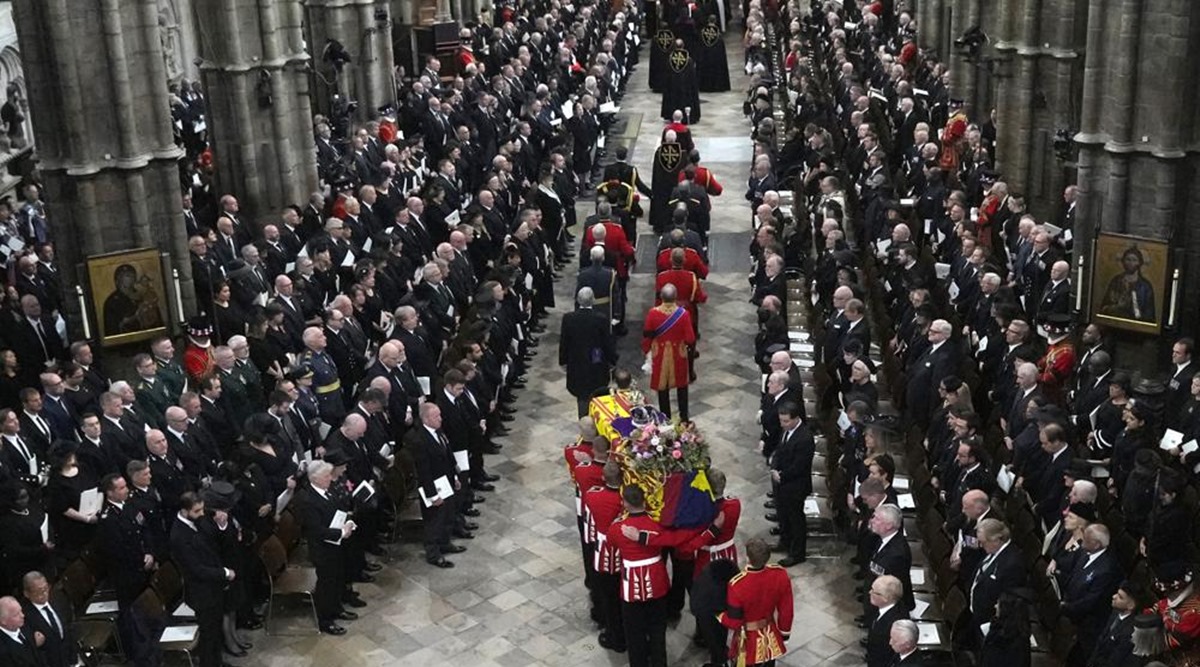 Although such rituals are very obviously played up in the United Kingdom, they are part of the routine elsewhere as well. (AP photo)
Although such rituals are very obviously played up in the United Kingdom, they are part of the routine elsewhere as well. (AP photo)I have avidly watched for long hours the television coverage of events in the United Kingdom immediately after the demise of Queen Elizabeth II on September 8, staying up late at night. I have asked myself what was my compulsion in doing so, as I am not a royalist even remotely. Nor do I have any personal interest in the British royalty. I had smugly laughed at my Sri Lankan friends who were lapping up the coverage of the Prince Charles-Diana Spencer wedding in 1981 when I was in that island nation. I have not had the slightest interest in watching the award-winning television serial based on the late Queen’s life.
I now realise what kept me glued to the tube was my fascination with the pomp and circumstance of the rituals of the Queen’s passing and her succession. Starting from the immediate announcement of her death and continuing all the way to her state, sorry, Royal funeral on September 18, everything was and will be ritualistically choreographed. Even those who do not play any formal role in the proceedings will all follow their own rituals. The television anchors and reporters all wear formal black, with women preferring traditional dresses and frocks to their usual pants suits (we are talking of Britain, where frocks are still common). The new prime minister, Liz Truss, curtseyed smartly when she received the official commission to form a government from the late Queen two days before her death and later when she had her first audience with the new King. She also ended her official announcement from 10 Downing Street with “God save the King.”
The Royal Guards cheering the new King, the proclamations in major cities of the United Kingdom and the so-called Realms, the King’s official signing as Charles R with a flourish, the slow progress of the cortege from Balmoral Castle eventually to Westminster could all have been part of a script by Gilbert and Sullivan with additional music by Edward Elgar. And those never-ending queues of people from everywhere to file past the casket, unbelievable! But the reports delicately avoided saying how those lining up for up to 24 hours managed their bodily functions in that time.
Although such rituals are very obviously played up in the United Kingdom, they are part of the routine elsewhere as well. The first colony to gain its independence from the British, the United States, has its own ceremonial drill for the inauguration of new presidents, with everything prescribed in all detail and scrupulously observed. Donald Trump was so impressed by the Bastille Day parade in France that he seriously advocated its equivalent to be included in the Fourth of July observances in the US. The “revolutionary” states of Russia and Peoples Republic of China have magnificent parades down the grand central boulevards in their capitals on their national days. And North Korea outdoes them all. Long ago in 1958, I had eagerly consumed all the details of formal papal succession which ended with plumes of white smoke rising from the Sistine Chapel dome followed by the announcement of “Habemus Papam” announcing the elevation of Pope John XXIII.
We have our own parade on the Republic Day, when the most impressive visuals are the smart marching of various armed units and their respective bands. Even when we proudly renounce colonial practices, we do so with a new set of rituals. We have indigenised the Beating of the Retreat after the Republic Day by including specially written music to replace the traditional numbers. The President’s annual address to the joint session of both houses of Parliament is our version of the speech from the throne.
National and international sports meets, including the Olympics, have ceremonial opening marches. Lately, the New Zealand indigenous peoples’ funeral rituals have featured impressively in mourning the passing of stars in rugby and even cricket.
My family has had its share of rituals. I still remember the visit of the Uttaradi Math swami to our ancestral home 75 years ago. It was the epitome of ceremonial observances. Shrinivas Joshi vividly describes such events in his magnificent Kannada novel, Halla Bantu Halla. My parents performed all worship according to set routines. My mother would severely reprimand her sons if they missed even the slightest detail when officiating for their father. Many decades later, Charles, then Prince of Wales, came to Anand in early 1980. His visit to the National Dairy Development Board campus (where we then lived) was among the high points. Little paper Union Jacks were distributed among children. My parents dressed up in their finest for the visit of the raja and ensured that my retarded younger brother did too. He was, however, happily looking and waving his flag in the direction opposite the prince’s path! An expatriate British expert’s wife practised long her curtsey. Her husband observed only half in jest that she would never again wash the hand that the prince had shaken.
So, I suppose our love for all these ceremonies is stamped into our DNA. I have a bucket list of two rituals I have not yet observed: Ms Truss (or her successor as prime minister of what is now truly Little Britain) apologising for the Jallianwala Baugh massacre and King Charles III (or his successor) doing the same for nearly two centuries of imperial exploitation of India on their respective next visits here.
The writer taught at IIM, Ahmedabad and was the founder-director of the Institute of Rural Management, Anand